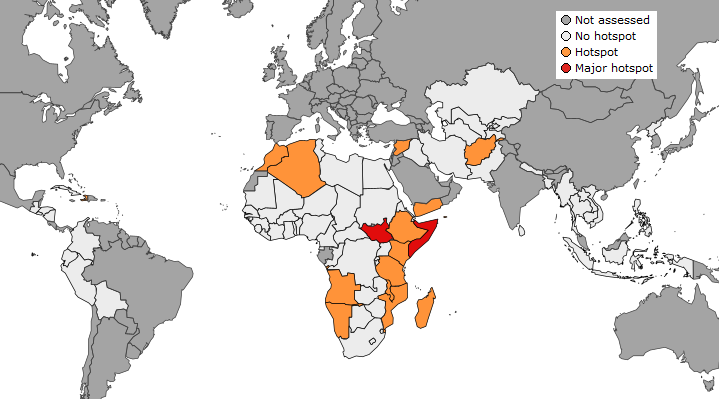
ASAP hotspot assessment February 2022
(c) European Union, 2022
The February edition of the JRC's Anomaly Hotspots of Agricultural Production (ASAP) assessment is now available at:
Anomaly Hotspots of Agricultural Production (ASAP) assessment
Main findings of the February global overview:
- In Southern Africa, although rainfall in January helped reduce seasonal moisture deficits and improved vegetation conditions in most parts of the region, the impact of drought and heat stress on vegetation conditions is still evident in south-western Angola, north-western Namibia, northern and central Mozambique, Malawi and Madagascar. In South Africa, the largest maize producer in the region, conditions have been generally good and maize production is forecast at an average level (Department of Agriculture).
- In East Africa, the bimodal areas are now in the dry season and are still facing the negative effects of severe drought during the previous rainy season. Particularly affected are northern and coastal Kenya, southern and central Somalia and southern Ethiopia, where three consecutive severe droughts have resulted in decreased crop production, shortages of forage, depleted water supplies, and weakened and depleted livestock herds. The food security situation remains alarming in South Sudan, and in Tigray, western Afar and northern Amhara in Ethiopia. Additionally, political instability in Sudan exposes millions of people to the risk of food insecurity.
- In North Africa, the winter cereal season continues to suffer from drought stress and rainfall has not improved in February in most areas. In Morocco and in western Algeria recovery of the crops is unlikely and reduced yields can be expected (see more on yield forecasts in the latest MARS bulletin). Similarly, in the Middle East, prospects for winter cereals are below average in the north of Syria and north and east of Iraq due to poor rainfall in Syria and poor socioeconomic conditions in both countries since autumn 2021. In contrast, the biomass of winter crops is still close to average in Iran despite below-average rainfall in the last three months in most parts of the country.
- In Central Asia, the biomass of winter crops is close to or above average, however with below-average rainfall forecast for the next 3 months, irrigation will be critical for crop production. In Afghanistan, a very large part of the population (up to 95%) suffers from food insecurity. In South Asia, prospects are favourable for Rabi crops (winter cereals) and Boro rice in Pakistan and Bangladesh respectively. In Sri Lanka, harvest of main season (Maha) rice and maize has started with close to average prospects.
- In South-East Asia, dry season rice is growing under favourable conditions with an increased area with respect to 2021 in Thailand and Cambodia. In Indonesia, wet season rice planted from November to March is in good conditions thanks to favourable rainfall.
- In Central America, the Postrera season harvest of maize and beans has been concluded with poor outputs in south-eastern Honduras and south-central Guatemala due the dry conditions early in the season. Third season maize and bean crops are progressing under generally favourable conditions. Heavy rains and strong winds have been affecting Haiti, Honduras and several southern American countries. Increased prices of basic grains since the end of 2021, pose an additional burden to households' food security.
The next assessment is scheduled for the end of March 2022.
Details
- Publication date
- 8 March 2022
- Author
- Joint Research Centre
